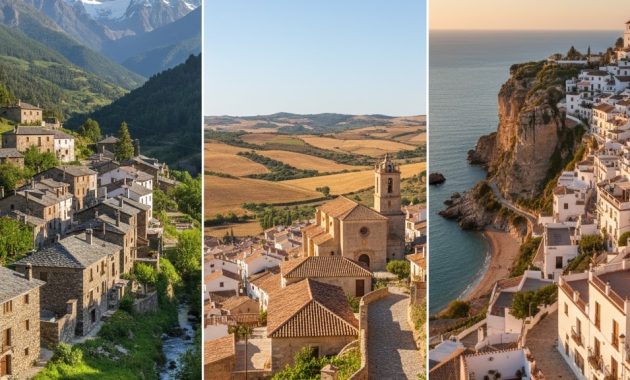
Where Time Stands Still in Spain’s Countryside
There’s something enchanting about wandering through the quiet, cobbled lanes of Spain’s countryside villages. Away from the bustle of Madrid and Barcelona, these towns offer a slower pace of life — where old stone houses, blooming geraniums, and church bells tell centuries-old stories.
From the misty peaks of the Pyrenees to the sun-kissed coasts of Andalusia, each Spanish village has its own character, shaped by history, landscape, and the warm spirit of its people. If you’re seeking authenticity, charm, and unforgettable photo moments, these are the most beautiful villages in Spain you shouldn’t miss.
1. Ronda – The Cliffside Jewel of Andalusia

Perched dramatically above El Tajo Gorge, Ronda is one of Andalusia’s most breathtaking sights. The iconic Puente Nuevo bridge connects the old Moorish town with the newer part, offering sweeping views of deep ravines and rolling hills.
Stroll along the old streets of La Ciudad, visit the 13th-century Arab Baths, and sip local wine at a terrace overlooking the gorge — it’s easy to see why Hemingway and Orson Welles both fell in love with this place.
2. Albarracín – A Medieval Dream in Aragon

Often called one of Spain’s prettiest villages, Albarracín feels like a step back in time. Surrounded by fortress walls and painted in a unique pinkish hue, this Aragonese gem is perched on a hilltop above the Guadalaviar River.
Wander through its labyrinthine alleys, admire the wooden balconies, and visit the Cathedral of El Salvador. The entire town looks like an open-air museum where medieval Spain still thrives.
3. Cudillero – The Colorful Fishing Village of Asturias
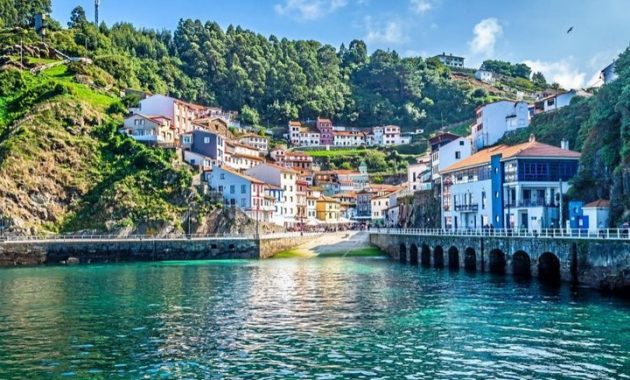
On Spain’s northern coast lies Cudillero, a postcard-perfect fishing village that spills down a hillside toward the Cantabrian Sea. Brightly painted houses climb up the slope, and narrow stairways lead to charming viewpoints over the harbor.
Locals claim each house’s color once represented a fisherman’s boat. Order a plate of grilled sardines or fabada asturiana and watch life unfold at a seaside café — this is Asturias at its best.
4. Frigiliana – The White Pearl of the Costa del Sol

Nestled in the hills above Nerja, Frigiliana is a maze of whitewashed houses, flower-filled balconies, and cobbled Moorish streets. Its blend of Moorish and Mediterranean architecture makes it one of the most photogenic towns in southern Spain.
As you wander, look for the 12 ceramic plaques telling the story of the Moorish uprising. Don’t miss local sweet wine and artisanal honey — Frigiliana’s flavors are as rich as its history.
5. Besalú – Romanesque Beauty in Catalonia
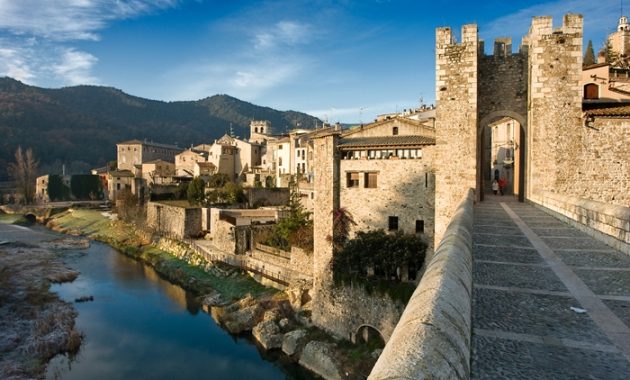
Crossing the medieval bridge into Besalú feels like entering a fairytale. With its stone houses, Romanesque churches, and cobbled streets, this Catalan village captures the essence of old Europe.
The 12th-century bridge over the Fluvià River is one of the best-preserved in Spain, and the Jewish Quarter offers a glimpse into centuries of coexistence and culture. Visit early morning when mist lingers — the view is pure magic.
6. Mijas Pueblo – A Balcony Over the Mediterranean

Mijas Pueblo, perched on the mountains of Malaga province, offers stunning views of the coast below. This whitewashed village is known for its narrow lanes, flowerpots on every wall, and calm Andalusian charm.
Ride one of its famous donkey taxis or simply sit with a coffee in Plaza de la Constitución, soaking up the sunshine and serenity.
7. Setenil de las Bodegas – Houses Built into Rocks

Perhaps one of the most unique villages in Spain, Setenil de las Bodegas is literally built beneath massive limestone overhangs. Streets like Calle Cuevas del Sol are shaded by natural rock ceilings, creating a surreal urban landscape.
The town’s name means “cellars,” as its caves once stored wine — today, they house tapas bars and shops. Try local chorizo and olive oil while marveling at nature’s architecture.
8. Valldemossa – Mallorca’s Mountain Retreat
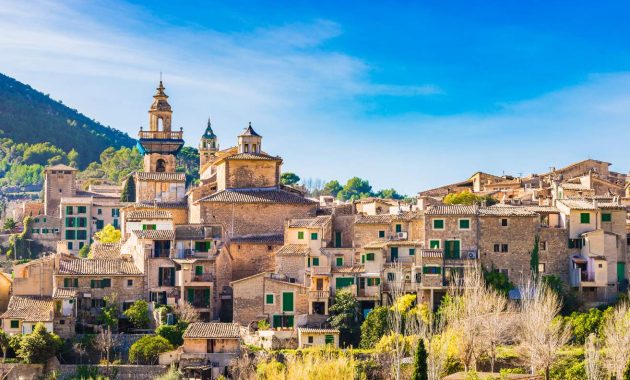
Tucked into the Tramuntana mountains, Valldemossa is a charming village of stone houses and cobbled alleys. Its peaceful atmosphere once inspired composer Chopin and writer George Sand, who spent a winter here in 1838.
Explore the Real Cartuja Monastery, wander through flower-decked streets, and savor a coca de patata (local sweet pastry) with coffee at a sunlit café.
9. Cadaqués – The Coastal Muse of Salvador Dalí
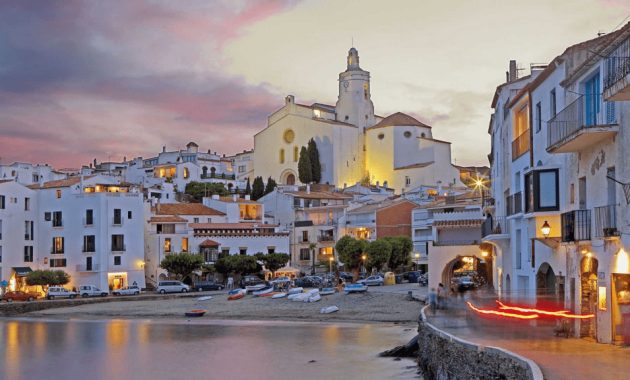
With its whitewashed homes, deep blue sea, and artistic soul, Cadaqués in Catalonia has long attracted painters, writers, and dreamers. Salvador Dalí once lived nearby in Portlligat, where his house remains a surreal museum.
Walk along the seaside promenade, explore Cap de Creus National Park, and enjoy a seafood meal as the Mediterranean sparkles at sunset.
10. Alquézar – A Hidden Treasure in Huesca

Alquézar, perched above the Vero River Canyon in the Pyrenees foothills, is an awe-inspiring mix of natural beauty and medieval charm. The fortified collegiate church dominates the skyline, while the hiking trails nearby lead through scenic canyons and crystal-clear waters.
It’s the perfect destination for travelers who want both adventure and tranquility.
Tips for Visiting Spain’s Villages
- Rent a car: Many villages are remote and not easily accessible by train or bus.
- Visit during weekdays: Avoid the weekend crowds and experience local life more peacefully.
- Stay overnight: Many villages become magical at night when day-trippers leave.
- Try local specialties: Each region has unique dishes — from Andalusian gazpacho to Basque pintxos.
- Respect the pace of life: Many shops close during siesta hours (2–5 p.m.).
FAQs About the Most Beautiful Villages in Spain
What is the most beautiful village in Spain?
Many travelers rank Ronda, Frigiliana, and Albarracín among the most beautiful due to their history and views.
Are Spain’s villages tourist-friendly?
Yes, most are safe and welcoming, though English may be limited in smaller towns.
How can I visit multiple villages on one trip?
The best way is by car, allowing flexibility to explore rural areas and hidden gems.
Is it safe to drive in rural Spain?
Absolutely. Roads are well-maintained, but expect narrow, winding paths in mountain areas.
When is the best time to visit Spanish villages?
Spring (April–June) and autumn (September–October) offer the best weather and fewer crowds.
Do I need to book accommodations in advance?
Yes, especially during summer or festival periods, as smaller villages have limited lodging.
Are there guided tours to these villages?
Yes, many local operators offer day trips or multi-day cultural tours.
Can I find vegetarian food in small villages?
It can be limited, but tapas like tortilla española and patatas bravas are always safe bets.
What’s the best region for charming small towns?
Andalusia, Catalonia, and Aragon are known for their picturesque and historic villages.
Do these villages accept credit cards?
Most do, but it’s smart to carry some euros for smaller cafés and markets.
Are pets welcome in rural Spain?
Generally, yes — especially in outdoor terraces and pet-friendly lodges.
Can I visit these villages using public transportation?
Some can be reached by regional bus, but car rental remains the most convenient option.
Final Verdict: Slow Down and Fall in Love with Rural Spain
The most beautiful villages in Spain are not just destinations — they’re living, breathing pieces of history. Each stone street, each bell tower, and each shared smile from a local tells the story of Spain’s soul beyond the cities.
Whether you’re sipping wine in Ronda, exploring the cliffs of Setenil, or breathing the mountain air of Valldemossa, you’ll find that rural Spain isn’t about seeing more — it’s about feeling more.
Ready to experience the real Spain? Start your journey through these timeless villages and discover the charm that keeps travelers returning again and again.